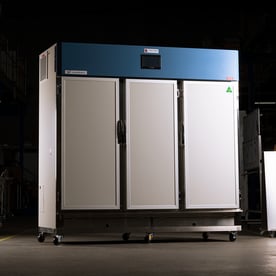In laboratory settings, precise and controlled conditions are essential for accurate and reliable testing and experimentation. Temperature and humidity are two of the critical factors that impact the performance and results of various laboratory tests, with the other being barometric pressure. These three things can influence the outcome given by laboratory test equipment and can often have calculations to be taken into account with the final answer. Please note that in the following, relative humidity is referred to as humidity.

How Temperature Relates to Humidity (Relative Humidity):
The relationship between temperature and humidity in laboratory testing cabinets is influenced by the concept of relative humidity (RH). Relative humidity is a percentage of the amount of water vapour in the air relative to the maximum amount the air can hold at a specific temperature. The air's capacity to hold water vapour increases as the temperature increases, which means that at higher temperatures, the air can hold more moisture, and the relative humidity decreases even if the absolute amount of water vapour remains constant.
Laboratory testing cabinets, also known as environmental chambers or incubators, are specially designed to create and hold specific temperature and humidity levels to meet the requirements of different experiments. This blog will examine how temperature and humidity relate in laboratory testing cabinets and the importance of achieving the right balance for successful research and testing. In these chambers, temperature and humidity are often the driving elements of the testing itself.
Humidity is the measure of moisture or water vapour in the air. In laboratory testing cabinets, humidity is controlled through a humidification system that adds moisture to the chamber or a dehumidification system that removes excess moisture to achieve the desired humidity level.
Thermoline produces two types of cabinets that control humidity: the Humiditherm range and the Envirotherm range. The Climatron plant growth range can also have humidity control, but it is usually done through additive means. Currently, the Humiditherm and Envirotherm models use an internal open water trough with an independent heating and cooling circuit.
Why Controlling Temperature and Humidity in Laboratory Testing Cabinets is Important:
Sample Stability: Many biological and chemical samples are sensitive to changes in temperature and humidity. Precisely controlling these parameters in testing cabinets ensures the stability of samples and prevents degradation, providing accurate and reliable results.
Consistency and Reproducibility: Maintaining a consistent and controlled environment in testing cabinets is crucial for achieving reproducible results. Fluctuations in temperature and humidity can introduce variability and compromise the validity of experimental data.
Mimicking Real-World Conditions: Some laboratory tests aim to simulate real-world conditions. For example, environmental testing, drug stability studies, and plant growth experiments require specific temperature and humidity levels to mimic natural environments accurately.
Material Testing: In material testing, temperature and humidity can affect the material's properties, such as strength, dimensional stability, and electrical conductivity. Precise control allows researchers to study how materials perform under different environmental conditions. One example of this is the curing time for concrete before strength testing.
Culturing Microorganisms: In microbiology and cell culture studies, maintaining specific temperature and humidity levels is essential for the growth and survival of microorganisms and cells. Lights can also be added to cabinets for tissue culture experiments.
Accelerated Aging Studies: For accelerated aging studies, where researchers test the effects of long-term exposure in a short period, precise temperature and humidity control are critical to obtaining meaningful results.
Conclusion:
Temperature and humidity are vital factors in laboratory testing cabinets, influencing the stability of samples, reproducibility of results, and accuracy of experiments. The relationship between temperature and humidity, as reflected in relative humidity, is central to achieving the right balance for successful research. Proper control of these parameters allows researchers to create a controlled environment that closely mimics real-world conditions, ensuring the validity and relevance of laboratory testing. Whether studying biological samples, conducting material tests, or exploring the effects of environmental conditions, precise control of temperature and humidity in laboratory testing cabinets plays a crucial role in removing fluctuating conditions for testing and improving our understanding of the natural world.
For more information on the Humiditherm and Envirotherm range, don't hesitate to contact us.






